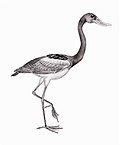| Stiff-tailed duck Temporal range: Early Miocene to present | |
|---|---|
 | |
| Male white-headed duck, Oxyura leucocephala | |
| Scientific classification | |
| Domain: | Eukaryota |
| Kingdom: | Animalia |
| Phylum: | Chordata |
| Class: | Aves |
| Order: | Anseriformes |
| Family: | Anatidae |
| Tribe: | Oxyurini |
| Genus: | Oxyura Bonaparte, 1828 |
| Type species | |
| Anas rubidus (ruddy duck) Wilson, 1814 | |
| Species | |
Oxyura australis Contents | |
 | |
| Key: Oxyura vittata Oxyura ferruginea Oxyura maccoa Oxyura leucocephala Oxyura jamaicensis Oxyura australis | |
The stiff-tailed ducks, the genus Oxyura, are part of the Oxyurini tribe of ducks.
All ducks in the genus have, as their name implies, long, stiff tail feathers which are erect when the bird is resting. They all have relatively large, swollen bills. These are freshwater diving ducks. Their legs are set far back, which makes them awkward on land and they rarely leave the water.
Their uncommon displays involve drumming noises from inflatable throat sacs, throwing its head back, and erect short crests on its head. Plumage sequences are complicated and aging difficult.[ citation needed ] Plumage is vital for survival because the bird spends most of its time in the water.


















